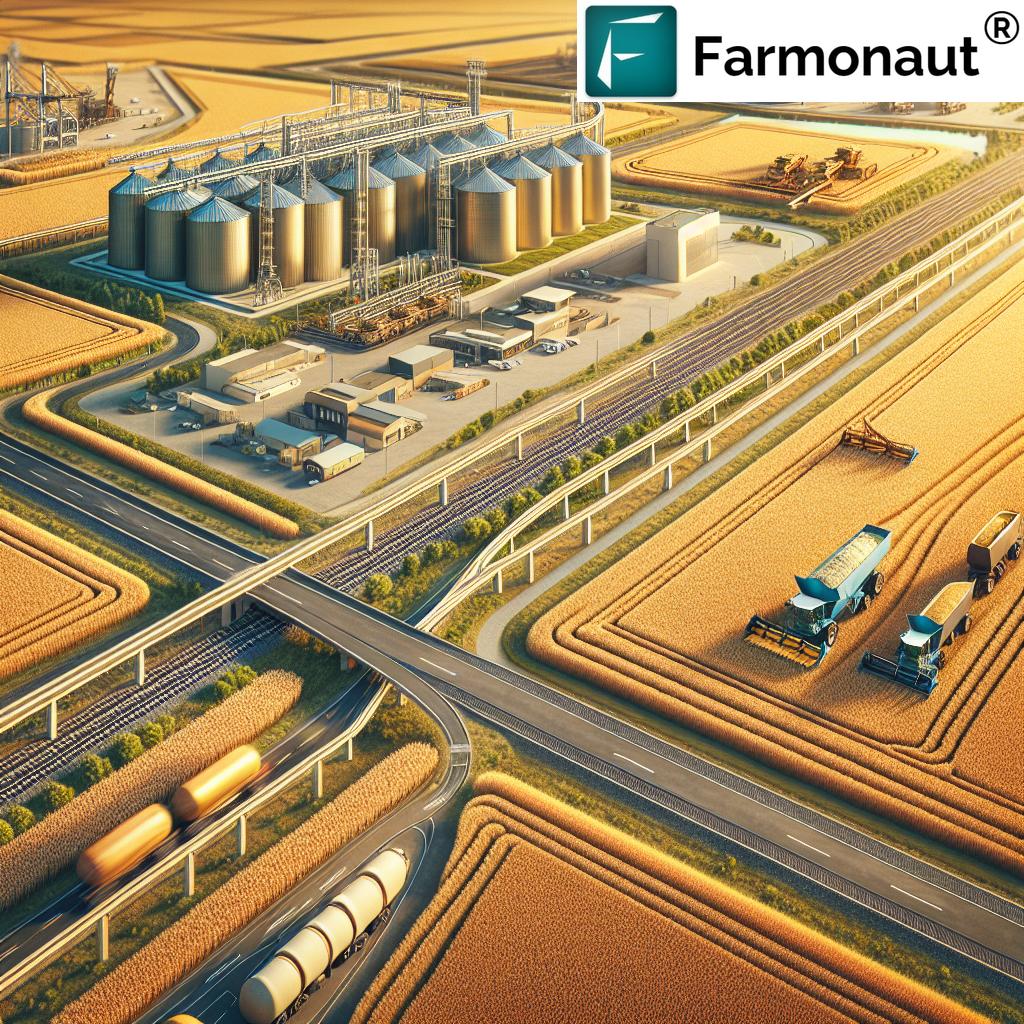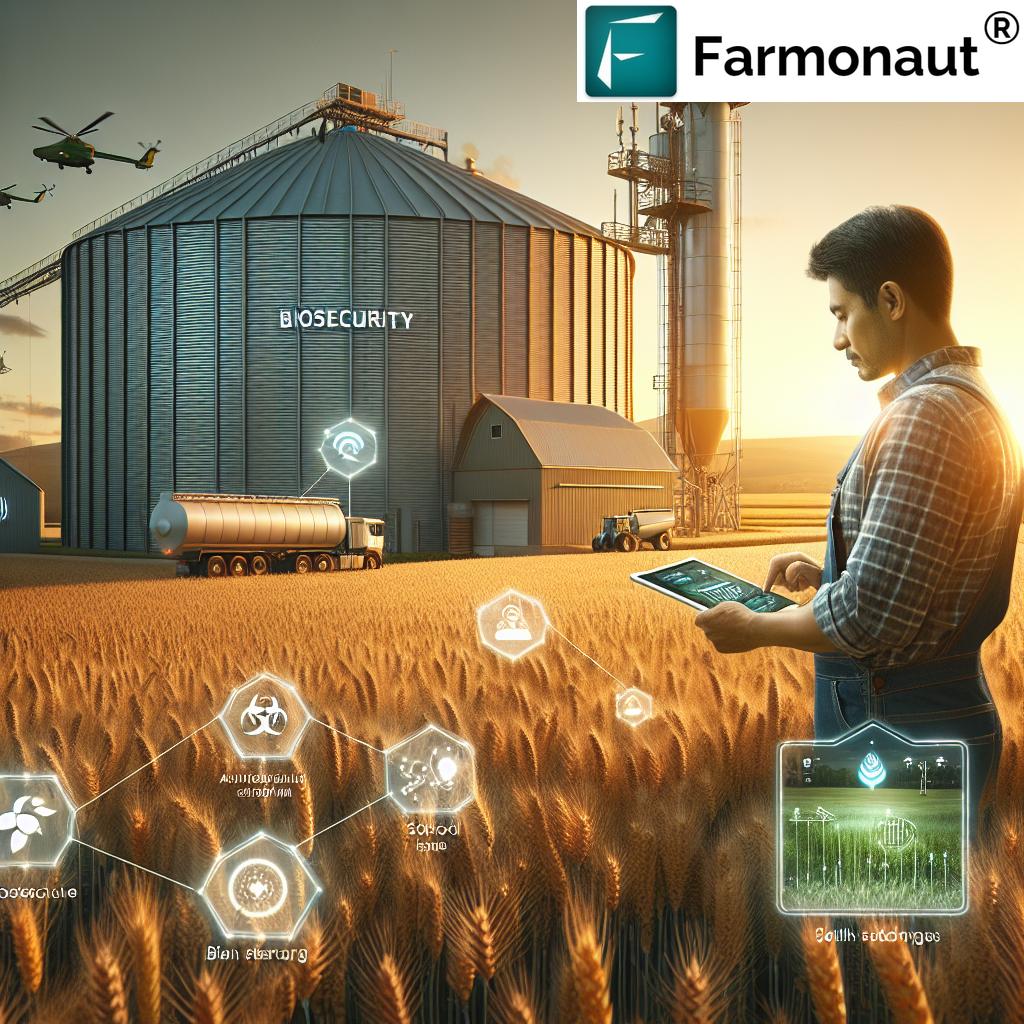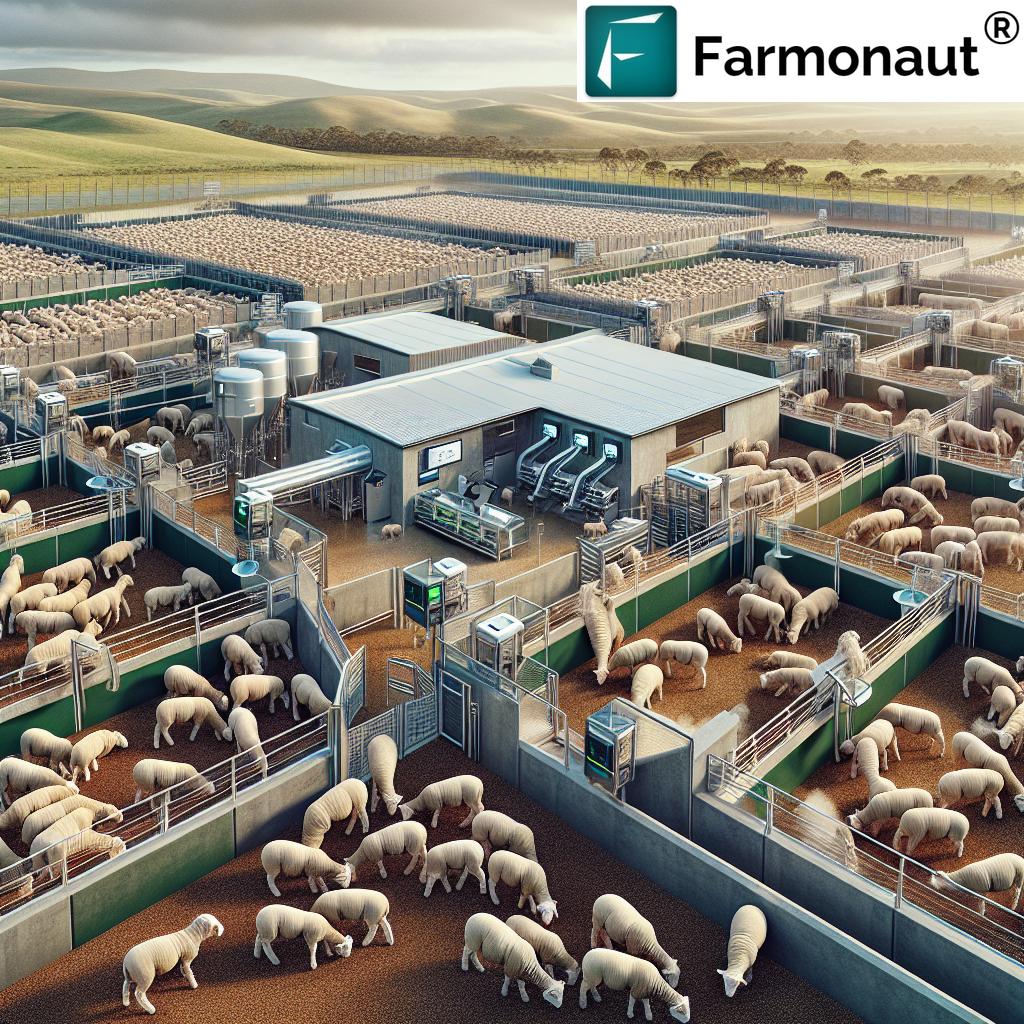Revolutionizing Australia’s Grain Supply Chain: Sustainable Solutions for Global Competitiveness and Food Security
“Australia’s grain industry is valued at $19 billion, highlighting its significant economic importance to the nation.”
In the vast landscape of Australian agriculture, the grain industry stands as a cornerstone of our nation’s economic prosperity and food security. As we navigate the challenges of the 21st century, we find ourselves at a critical juncture where enhancing grain supply chain efficiency and fostering Australian agriculture innovation are no longer optional—they are imperative for the future of our $19 billion grain industry.
In this comprehensive exploration, we will delve into the intricate web of challenges faced by our growers in maintaining global competitiveness and ensuring food security amidst complex transport routes and recent disruptions. We’ll uncover how the National Grain Freight Strategy aims to revolutionize agricultural freight solutions, transforming the journey from paddocks to ports and domestic markets.

The Current State of Australia’s Grain Supply Chain
Australia’s grain supply chain is a complex network that stretches across our vast continent. From the golden wheat fields of Western Australia to the diverse croplands of New South Wales and Victoria, our grain industry is a testament to the resilience and innovation of Australian farmers. However, this extensive network also presents unique challenges that we must address to maintain our competitive edge in the global market.
- Complex Transport Routes: Our grain travels vast distances, often utilizing a combination of road, rail, and sea transport.
- Climate Variability: Extreme weather events, including bushfires and floods, have significantly impacted our supply chains in recent years.
- Infrastructure Gaps: Many rural areas lack modern infrastructure, hindering efficient grain transport.
- Regulatory Hurdles: Inconsistent regulations across states can create bottlenecks in the supply chain.
These challenges have underscored the need for a comprehensive strategy to revolutionize our grain supply chain. The National Grain Freight Strategy emerges as a beacon of hope, promising to address these issues and pave the way for a more resilient and efficient future.
The National Grain Freight Strategy: A Game-Changer for Australian Agriculture
“The National Grain Freight Strategy aims to revolutionize agricultural freight solutions across Australia’s complex transport routes.”
The National Grain Freight Strategy represents a collaborative effort between government, industry stakeholders, and agricultural experts to transform the way we move grain across our nation. This comprehensive plan focuses on several key areas:
- Infrastructure Development: Upgrading and expanding our rural road and rail networks to handle increased grain volumes efficiently.
- Regulatory Harmonization: Working towards consistent regulations across states to streamline the transport process.
- Technology Integration: Implementing cutting-edge technologies to optimize logistics and reduce waste.
- Sustainability Measures: Promoting environmentally friendly transport solutions to reduce the industry’s carbon footprint.
By addressing these critical areas, the strategy aims to significantly reduce transport costs, increase efficiency, and bolster Australia’s position as a leading global grain exporter.
Sustainable Grain Production: The Foundation of a Resilient Supply Chain
While optimizing our transport infrastructure is crucial, the foundation of a robust grain supply chain lies in sustainable grain production. Australian farmers are at the forefront of adopting innovative practices to increase yields while preserving our precious natural resources.
- Precision Agriculture: Utilizing satellite technology and data analytics to optimize resource use.
- Water-Efficient Farming: Implementing advanced irrigation systems and drought-resistant crop varieties.
- Soil Health Management: Employing techniques like crop rotation and cover cropping to maintain soil fertility.
- Integrated Pest Management: Reducing reliance on chemical pesticides through biological control methods.
These sustainable practices not only enhance productivity but also contribute to the long-term viability of our grain industry. By producing more with less, we can meet growing global demand while minimizing our environmental impact.
Optimizing Grain Export Logistics: From Farm to Global Markets
Australia’s position as a major grain exporter demands a seamless export logistics system. We’re working tirelessly to streamline the journey from farm to port, ensuring that our high-quality grain reaches international markets efficiently and competitively.
- Port Infrastructure Upgrades: Investing in modern grain handling facilities at key export terminals.
- Digital Supply Chain Management: Implementing blockchain and IoT technologies for real-time tracking and transparency.
- Containerization Solutions: Exploring innovative containerization methods to improve flexibility in shipping.
- Strategic Trade Partnerships: Fostering relationships with key importing nations to secure long-term market access.
By optimizing our export logistics, we’re not just improving efficiency—we’re enhancing Australia’s reputation as a reliable and quality-focused grain supplier on the global stage.
Rural Infrastructure Development: Bridging the Gap
The success of our grain supply chain hinges on the development of robust rural infrastructure. We recognize the pressing need to invest in our regional and rural areas to support the efficient movement of grain and enhance the quality of life for our farming communities.
- Road Network Improvements: Upgrading key rural roads to accommodate heavy grain trucks and improve safety.
- Rail Revitalization: Modernizing our rail infrastructure to handle larger grain volumes and reduce reliance on road transport.
- Digital Connectivity: Expanding high-speed internet access in rural areas to support precision agriculture and smart logistics.
- Community Development: Investing in rural towns to attract and retain skilled workers in the agricultural sector.
These infrastructure investments are not just about moving grain—they’re about building sustainable, thriving rural communities that form the backbone of our agricultural industry.
Explore Farmonaut’s API for advanced agricultural data solutions
Regulatory Reforms: Streamlining for Efficiency
To truly revolutionize our grain supply chain, we must address the regulatory environment that governs it. We’re advocating for smart, harmonized regulations that protect our industry while promoting innovation and efficiency.
- Cross-Border Harmonization: Working towards consistent regulations across state lines to reduce transport bottlenecks.
- Simplified Compliance: Streamlining reporting and compliance processes to reduce administrative burdens on farmers and transporters.
- Performance-Based Standards: Implementing flexible, outcome-focused regulations that encourage innovation in transport solutions.
- International Alignment: Ensuring our regulatory framework aligns with international best practices to facilitate seamless exports.
By creating a more conducive regulatory environment, we can unleash the full potential of our grain industry, driving productivity and reducing costs for our hardworking farmers.

Leveraging Technology for Supply Chain Excellence
In the digital age, technology plays a pivotal role in revolutionizing our grain supply chain. We’re embracing cutting-edge solutions to enhance efficiency, transparency, and sustainability across the entire supply network.
- Satellite-Based Crop Monitoring: Utilizing advanced satellite imagery for real-time crop health assessment and yield prediction.
- AI-Powered Logistics Optimization: Implementing artificial intelligence to optimize transport routes and reduce fuel consumption.
- Blockchain for Traceability: Adopting blockchain technology to ensure transparency and build trust in our grain supply chain.
- Internet of Things (IoT) Sensors: Deploying IoT devices for real-time monitoring of grain quality during storage and transport.
These technological advancements are not just improving our supply chain—they’re transforming the way we approach agriculture, making it smarter, more sustainable, and more responsive to global market demands.
Access Farmonaut’s API Developer Docs for integrating advanced agricultural data into your systems
Enhancing Food Security: Australia’s Role in Global Grain Supply
As we optimize our grain supply chain, we’re not just thinking about our national interests—we’re considering our crucial role in global food security. Australia’s grain exports play a vital part in feeding the world, and we take this responsibility seriously.
- Diversifying Export Markets: Expanding our reach to new international markets to ensure a stable supply of grain worldwide.
- Quality Assurance Protocols: Implementing rigorous quality control measures to maintain the high standards of Australian grain.
- Climate-Resilient Varieties: Investing in research to develop grain varieties that can withstand changing climate conditions.
- International Cooperation: Collaborating with global partners to share knowledge and best practices in sustainable grain production.
By strengthening our supply chain, we’re not just securing Australia’s economic future—we’re contributing to global food security and positioning ourselves as a reliable partner in times of need.
The Road Ahead: Challenges and Opportunities
As we forge ahead with our plans to revolutionize Australia’s grain supply chain, we must remain cognizant of the challenges that lie ahead. Climate change, geopolitical tensions, and evolving consumer preferences all pose potential disruptions to our industry. However, with these challenges come opportunities for innovation and growth.
- Climate Adaptation: Developing strategies to mitigate the impacts of climate change on our grain production and supply chain.
- Market Diversification: Exploring new value-added products and markets to reduce dependency on traditional export channels.
- Workforce Development: Investing in education and training to build a skilled workforce capable of managing a high-tech grain supply chain.
- Collaborative Innovation: Fostering partnerships between farmers, researchers, and technology providers to drive continuous improvement.
By addressing these challenges head-on and seizing the opportunities they present, we can build a grain supply chain that is not just efficient and sustainable, but also resilient and adaptive to future changes.
Conclusion: A Vision for a Sustainable and Competitive Future
As we conclude our exploration of Australia’s grain supply chain revolution, it’s clear that the path forward is both challenging and exciting. By embracing sustainable production methods, optimizing our logistics networks, and leveraging cutting-edge technologies, we’re not just improving our supply chain—we’re reshaping the future of Australian agriculture.
The journey ahead requires collaboration, innovation, and a unwavering commitment to excellence. But with the strategies and initiatives outlined in this article, we’re confident that Australia’s grain industry will not only meet the challenges of the 21st century but thrive in the face of them.
As we move forward, let’s remember that every improvement in our grain supply chain is a step towards greater food security, economic prosperity, and environmental sustainability. Together, we can build a grain industry that is truly world-class—efficient, resilient, and ready to feed the world for generations to come.
Australian Grain Supply Chain Challenges and Solutions
| Challenge | Impact | Sustainable Solution |
|---|---|---|
| Complex Transport Routes | Increased transport costs by up to 30% | Integrated multimodal transport systems; AI-powered route optimization |
| Rural Infrastructure Gaps | Productivity losses estimated at $2 billion annually | Strategic investment in rural roads and rail; public-private partnerships for infrastructure development |
| Regulatory Barriers | Compliance costs of $400 million per year | Harmonization of cross-border regulations; streamlined compliance processes |
| Climate Variability | Yield fluctuations of up to 50% in drought years | Investment in climate-resilient crop varieties; advanced weather forecasting integration |
| Technology Adoption | Potential efficiency gains of 15-20% unrealized | Promotion of precision agriculture; subsidies for technology adoption in rural areas |
FAQ: Revolutionizing Australia’s Grain Supply Chain
Q1: What is the main goal of the National Grain Freight Strategy?
A1: The National Grain Freight Strategy aims to revolutionize agricultural freight solutions across Australia by optimizing transport routes, upgrading infrastructure, and integrating advanced technologies to enhance the efficiency and competitiveness of the grain supply chain.
Q2: How does sustainable grain production contribute to supply chain efficiency?
A2: Sustainable grain production practices, such as precision agriculture and water-efficient farming, increase yields while reducing resource use. This leads to more consistent and higher-quality grain production, which in turn supports a more efficient and reliable supply chain.
Q3: What role does technology play in improving the grain supply chain?
A3: Technology plays a crucial role in optimizing the grain supply chain through satellite-based crop monitoring, AI-powered logistics optimization, blockchain for traceability, and IoT sensors for real-time quality monitoring. These technologies enhance efficiency, transparency, and decision-making throughout the supply chain.
Q4: How is Australia addressing the challenges of climate change in its grain industry?
A4: Australia is addressing climate change challenges through the development of drought-resistant crop varieties, implementation of water-efficient farming techniques, and integration of advanced weather forecasting into agricultural planning. These measures aim to increase the resilience of grain production in the face of changing climate conditions.
Q5: What are the key benefits of improving Australia’s grain supply chain?
A5: Improving Australia’s grain supply chain offers numerous benefits, including reduced transport costs, increased global competitiveness, enhanced food security, improved sustainability, and greater economic prosperity for rural communities and the nation as a whole.
















